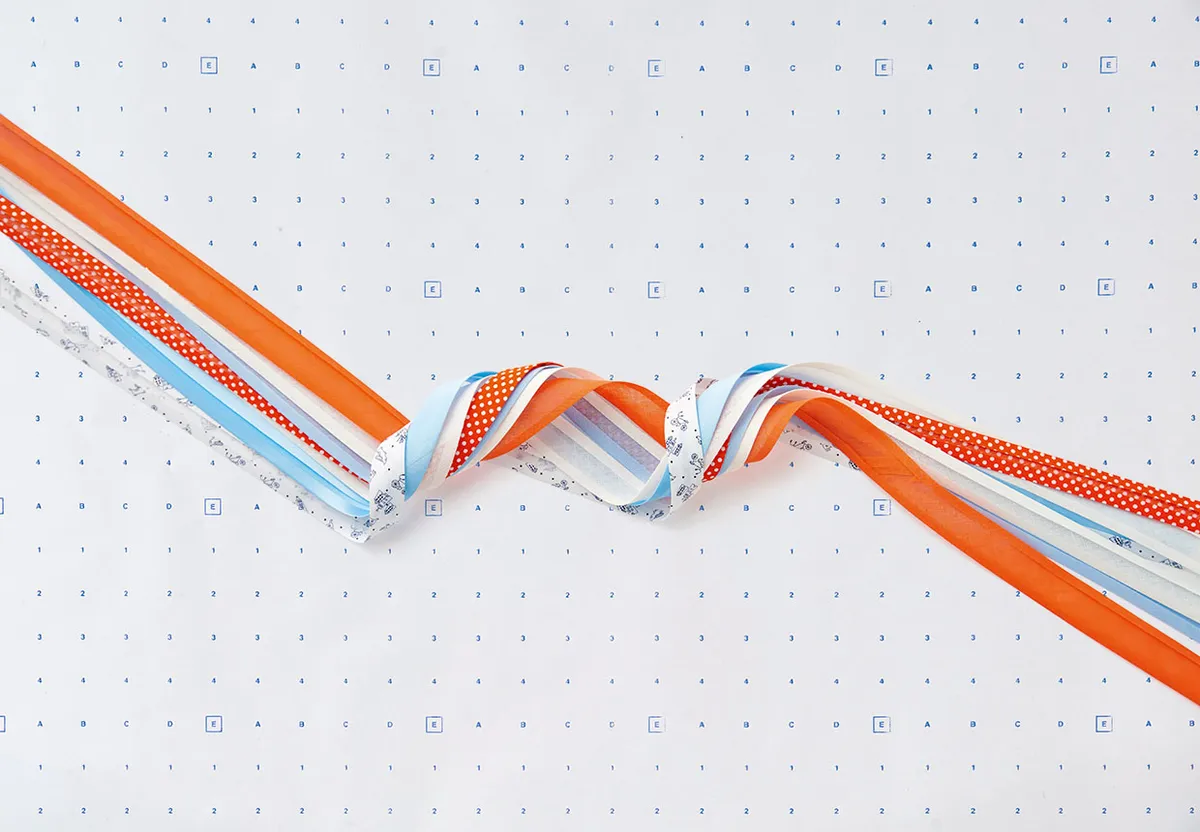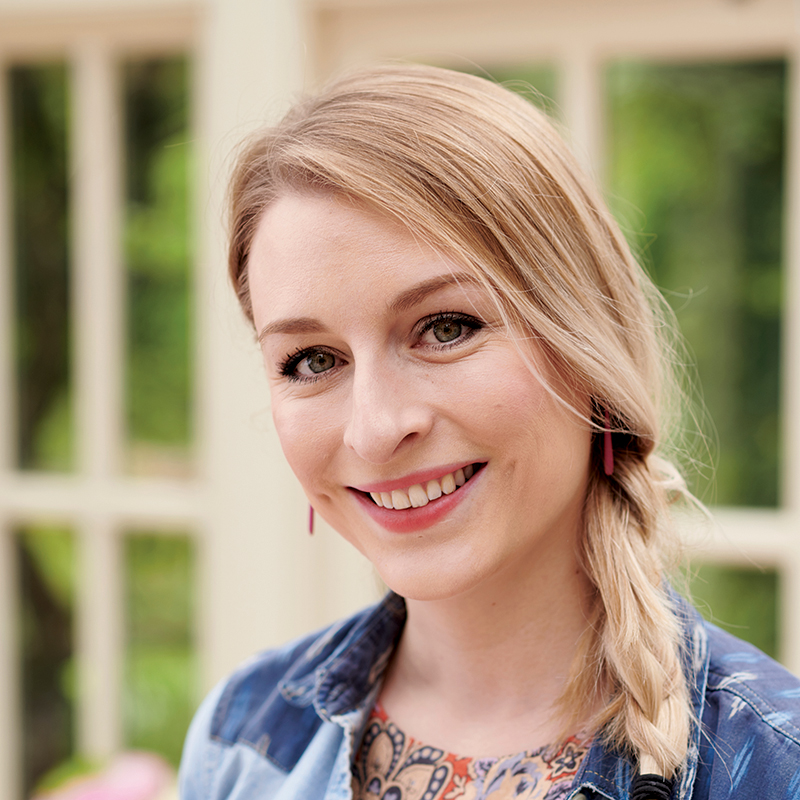How to sew curved binding: tips and tricks
A curved edge adds interest to a quilt, can complement curved piecing, and can be faster than mitring the corners on a square quilt. Whether you just want to round the corners of your quilt or fancy a fully scalloped border, learning how to add binding to a curved edge can enhance your quilt making repertoire. This is especially easy with binding clips.
Read on for Laura’s top tips for creating those perfect curves, including her walkthrough guide to sewing wavy, rounded or scalloped binding.
"Binding clips gave us the inspiration for this article – they aren’t just handy for binding … we’ve been using ours for everything from paper piecing to pinning our fabric wish lists to our fridges at home. They’re easier to use than pins (especially when you’re securing thick layers of fabric), they don’t leave holes and they’re easy to reposition without the worry of pricking your fingers!" says Laura Pritchard.
In this guide we'll look at how to use a template to create a curved edge, how to cut your binding on the bias and much more.
You will need:
- Fabric
- Cutting mat
- Sewing machine
- Rotary cutter or scissors
- Bias strips
- Basic sewing kit
How to use a template to create a curved edge
Step 1
“I find this easiest to achieve by using a dinner plate or bowl as a template, though you can purchase special “bendy” rulers which can be moulded into arcs or “S” shapes and then drawn around,” Laura says.
“When raiding your crockery, choose something large for a gentler curve or a small dish for a sharper curve. Place the template face down on the quilt and use a marker to draw around it – this doesn’t need to be removable as it will be hidden by the binding, though it’s best not too use anything too dark if your binding is going to be made from light fabric. This technique can be used to create both convex and concave curves by alternating the position of the plate. Mixing and matching dish sizes will create a quirky irregular effect.

Step 2
When you’re happy with the marked corners/edges, carefully cut out along the line with your rotary cutter or scissors.

Step 3
You may wish to zig-zag the edges together at this point, before adding the binding but this is a personal choice and isn’t a necessary step.

How to cut your binding on the bias
Step 1
To bind curves you’ll need to cut your binding strips on the bias as this has more stretch than the straight grain. Trying to bind corners with straight grain strips will create undesirable results as they won’t have the bend and give that the bias has. To cut bias strips, position your ruler at a 45-degree angle. If your ruler isn’t long enough to cut across the full diagonal, fold your fabric as follows…

Fold the bottom left corner up to meet the top raw edge of the fabric. Use your ruler to check this is forming a 45-degree angle.
Step 2
Now fold the bottom right corner up in line with the fold. You can also fold the top left corner down to meet the fold if the piece is still too big. Make sure the folds are all sitting exactly on top of one another.

Step 3
Using a sharp rotary cutter blade, as you are cutting through several layers, line up your ruler just shy of the fold to cut the fold off. Now position your ruler aligning the desired strip width with the cut 45-degree edge. Cut your first strip. Continue to cut subsequent strips along the fabric in this way.

Step 4
When you open the cut pieces out, you will have a few bias strips of varying lengths.

Step 5
These should have 45-degree angles at each end. Check the angle and trim if necessary.

How to pattern match for best results
Step 1
Follow this quick guide for joining your binding strips when you’re using a print fabric…
Step 2
Take two bias strips and rotate them so that the angled ends slope in the same direction.
Step 3
If you’re using striped fabric, the stripes should also face the same way.
Step 4
Line up the strips to form a right angle. You will have small “dog-ears” where the corners are offset; this will guide where your 1⁄4in seam should start and end. Stitch along the angled edge with a 1⁄4in seam then press open.
Step 5
Continue to add strips until you have a continuous length that is long enough for the perimeter of your quilt plus approximately 15in. Fold the strip in half lengthwise, wrong sides together and press along the length. Your bias binding strip is now complete.
How to store your binding
Step 1
Roll up! When you’ve finished preparing your binding strip, store it rolled for easy handling (and to avoid creating accidental creases and folds).
How to clip your binding
Step 1
Using your binding clips, fasten your binding strip in place around the edge of the quilt, aligning the raw edges. You will find it easier to join the ends on a straighter part of the quilt edge, so keep this in mind when choosing where to start.
Ease the binding around the curved parts of your raw quilt edge – because it is stretchy it will do as you tell it. Clip regularly – every couple of inches is good.
Step 2
You do not need to clip the full length of your binding in place all in one go. You can work a bit at a time… reusing the clips to attach the binding several inches ahead.
How to measure your seam allowance
Step 1
Once clipped in place, you can either machine-stitch-it to the front and then finish by hand stitching to the back, or you may want to do it all by machine, in which case first clip it to the back. Take your quilt to the machine and begin stitching your seam. When machine sewing binding to your machine, shift your needle position so it’s 1⁄3 of the folded binding strip minus 1⁄8in. For example, if you’ve cut binding strips 2½in wide, this will become 1¼in once folded. 1¼in minus 1⁄8in divided by 3 = 3⁄8in. So, make your seam 3⁄8in when you attach your binding. This will mean your binding will overlap the stitching by just the right amount when you fold it over to the other side.
Step 2
Stitch around the perimeter of the quilt, removing the clips as you go. Stop with the needle in the work, lift your presser foot and pivot regularly to create nice smooth curves and avoid puckers
How to use binding clips to mark your seams
Step 1
You can use the end of your binding clips to mark the seam too. If you combine this technique with a zipper foot, this will allow you to stitch right alongside the binding clip without removing it.
Attach all the binding and join the ends as you would with regular binding. Press the binding away from the quilt centre and over to the back of the quilt. Use your binding clips to hold the binding in place on the back, you will see it easily forms nice curves and should cover the stitching line. Hand stitch in place with slip-stitch using a matching thread.
How to improve your top stitch accuracy
Step 1
Alternatively, if you are machine stitching your binding, you can use the end of your binding clip to mark the previous stitch line to make sure your topstitch sits in the “ditch” of the binding on the back.
Your curved binding is now complete! See how much simpler that was with clips than with pins?
Binding clips have a myriad of other uses too. They’re handy for sorting piles of patchwork units…

… as well as holding pieces together for English Paper Piecing!

Finish your quilts like a pro
With the right tips and a little practice, sewing curved binding becomes a simple way to give your projects a smooth, professional finish.
How to sew bias binding workshop
Read our how to sew bias binding workshop to learn how it's done.



